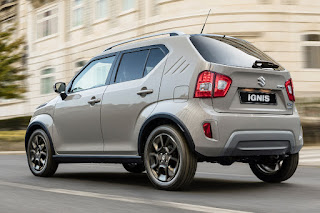Updated 2020 Suzuki Ignis unveiled
Suzuki has given its SUV-styled Ignis city car a mild facelift. The design changes might be hard to spot, but the bumpers, front grille and instruments have all been revised. There are some new exterior and interior colour schemes, too.
In addition, the 1.2 litre Dualjet petrol engine gets modified fuel injection, plus the lithium-ion battery pack for the available mild hybrid system has more than tripled in size to 10 Ah.
However, output is actually down from 88 bhp (66 kW / 90 PS) to 81 bhp (61 kW / 83 PS), while peak torque has similarly reduced by 13 Nm (9 lb/ft) to 107 Nm (79 lb/ft). Consequently, performance suffers and efficiency benefits.
For example, a new hybrid-equipped Ignis fitted with the standard five-speed manual gearbox can accelerate from rest to 62 mph (100 km/h) in 12.7 seconds, before going on to a top speed of 103 mph (165 km/h). Before, those figures were 11.8 seconds and 106 mph (170 km/h).
The same model now records 55.7 mpg (5.1 l/100km) with CO2 emissions of 114 g/km on the WLTP Combined cycle. By comparison, it previously achieved 54.1 mpg (5.3 l/100km) and 117 g/km.
Other developments include the introduction of a continuously-variable automatic transmission, which replaces the old five-speed automated manual on the options list. Any customers who envisage driving over rough terrain will still be able to order Allgrip four-wheel drive (in conjunction with the regular manual gearbox).
Although Suzuki has yet to announce prices and final specifications for the 2020 Ignis, deliveries are due to commence in April.
In addition, the 1.2 litre Dualjet petrol engine gets modified fuel injection, plus the lithium-ion battery pack for the available mild hybrid system has more than tripled in size to 10 Ah.
However, output is actually down from 88 bhp (66 kW / 90 PS) to 81 bhp (61 kW / 83 PS), while peak torque has similarly reduced by 13 Nm (9 lb/ft) to 107 Nm (79 lb/ft). Consequently, performance suffers and efficiency benefits.
For example, a new hybrid-equipped Ignis fitted with the standard five-speed manual gearbox can accelerate from rest to 62 mph (100 km/h) in 12.7 seconds, before going on to a top speed of 103 mph (165 km/h). Before, those figures were 11.8 seconds and 106 mph (170 km/h).
The same model now records 55.7 mpg (5.1 l/100km) with CO2 emissions of 114 g/km on the WLTP Combined cycle. By comparison, it previously achieved 54.1 mpg (5.3 l/100km) and 117 g/km.
Other developments include the introduction of a continuously-variable automatic transmission, which replaces the old five-speed automated manual on the options list. Any customers who envisage driving over rough terrain will still be able to order Allgrip four-wheel drive (in conjunction with the regular manual gearbox).
Although Suzuki has yet to announce prices and final specifications for the 2020 Ignis, deliveries are due to commence in April.










Comments
Post a Comment